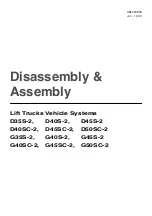
9
1
2
FIGURE 13. HANDLING MOTORS
11541
1. SLING
2. LIFTING EYE
HORIZONTAL LIFTING
VERTICAL LIFTING
12889
MOTOR INSULATION CLASS
Motor windings must be electrically insulated from
each other to prevent a short circuit. Insulation materials
include glass cord, mica, silicone glass, and varnish
glass. This insulation is subject to the aging effects of
heat. A class rating has been set up based on a motor’s
ability to withstand a specific temperature over a
specific period of operation. The insulation type is a
significant factor in determining the class rating. Most
of the motors used in Hyster Electric Trucks are class
“H”. The class “H” motor must withstand an armature
temperature of 177
°
C (350
°
F). The motor’s frame
temperature is normally l0 to 37
°
C (50 to 100
°
F) lower
than the armature temperature which is measured
internally. The operating temperature of the motor’s
frame is generally too hot to touch. The permanent
magnet motor used for power steering is not given an
insulation class rating because the magnets have a low
maximum operating temperature (about 93
°
C or
200
°
F).
STORAGE
The motor should be stored in a clean dry place if it is not
to be installed immediately. Protect it from low
temperatures and sudden changes in temperature or
humidity. The brushes should be lifted off the
commutator during extended storage periods otherwise
corrosion may occur and later result in flat spots on the
commutator.
HANDLING
Heavy motors with vertical drive should be lifted with a
lifting eye screwed onto the shaft. Motors that mount
horizontally may be lifted and handled with a sling
around the frame. Care should be exercised to protect
terminals, shaft extension(s) and accessories from
damage during handling.
CAUTION
Permanent magnet motors have Ceramic magnets
that are brittle. Do not strike or drop a PM motor.
BREAK–IN OPERATION
Break–in is a very critical time for the commutator and
the brushes. With a little care the brushes will wear–in
and provide reasonable service life, however, with
abuse they can rapidly wear–out. A new or
reconditioned commutator is bright and shiny
indicating that the brushes have not yet completely
conformed to the commutator. After a short operating
period (40 to 100 hours) a protective film builds up on
the commutator and the brushes exactly conform to the
commutator. When the brushes are properly seated–in,
the commutator will have a dull, thin, dark chocolate
coating which is relatively uniform. NEVER break–in
any motor with an inadequate battery charge (1.240 or
lower).
No special procedure is required to break–in the traction
motor(s); however, any traction motor will benefit if the




































